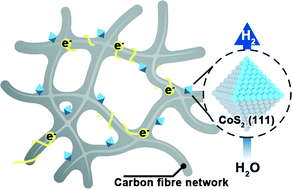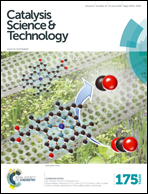Well-dispersed CoS2 nano-octahedra grown on a carbon fibre network as efficient electrocatalysts for hydrogen evolution reaction†
Abstract
Increasing the number of active sites of a non-noble metal catalyst is an effective route to make its overall catalytic performance close to that of noble metals. Herein, we report a novel confinement strategy for preparing well-dispersed octahedral CoS2 nanocrystals through in situ sulfidization of the carbon fibre-wrapped Co nanoparticles, in order to fully expose the active sites of every nanocatalytic unit. The successful synthesis of the material includes three main steps: (i) electrospinning synthesis of Co ion-containing polyacrylonitrile fibres (Co2+-PANF), (ii) thermal conversion of the Co2+-PANF at 900 °C under N2 atmosphere into a Co-embedded carbon fibre network (Co-CFN), and (iii) direct sulfidization of Co-CFN using sublimed sulphur, leading to the confinement growth of CoS2 nano-octahedra on CFN. Furthermore, this material, denoted as CoS2-CFN, can serve as a highly active, stable, non-noble metal electrocatalyst for hydrogen evolution reaction in acidic medium. This material generates a current density of 10 mA cm−2 at a small overpotential of 136 mV with about 100% Faradaic yield and maintains its catalytic activity for at least 20 hours. The excellent catalytic properties of CoS2-CFN are attributed primarily to the synergistic effects of the intrinsic catalytic ability of CoS2, the well-dispersed CoS2 nanocrystals as the catalytically active phase, as well as the high conductivity and porous structure of the carbon fibre network as a support material.


 Please wait while we load your content...
Please wait while we load your content...